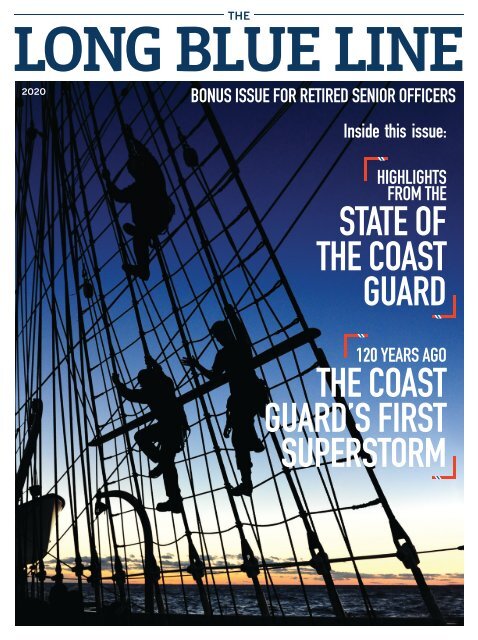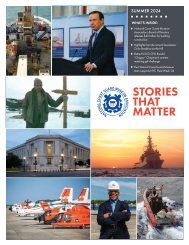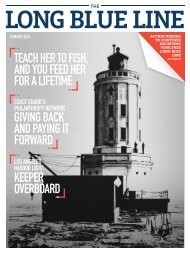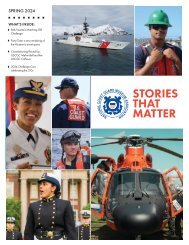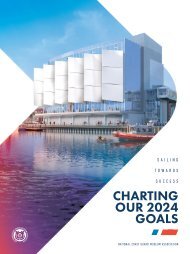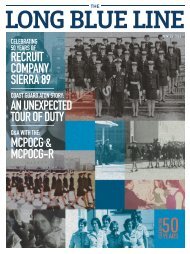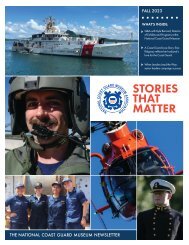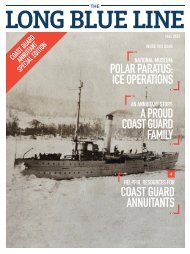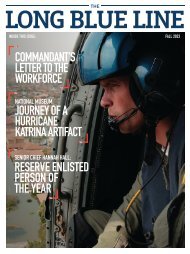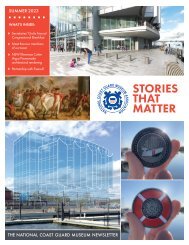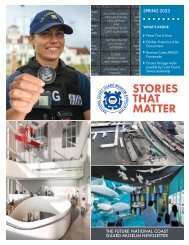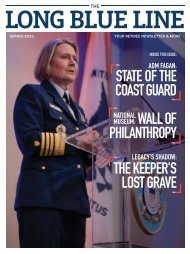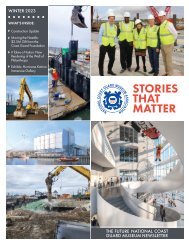The Long Blue Line (Supplemental 2020)
You also want an ePaper? Increase the reach of your titles
YUMPU automatically turns print PDFs into web optimized ePapers that Google loves.
<strong>2020</strong><br />
BONUS ISSUE FOR RETIRED SENIOR OFFICERS<br />
Inside this issue:<br />
HIGHLIGHTS<br />
FROM THE<br />
STATE OF<br />
THE COAST<br />
GUARD<br />
120 YEARS AGO<br />
THE COAST<br />
GUARD’S FIRST<br />
SUPERSTORM
INSIDE THIS ISSUE<br />
3<br />
Introducing the <strong>Long</strong> <strong>Blue</strong> <strong>Line</strong> Bonus Issue<br />
A message from CDR Kevin Harkins, USCG (Ret.)<br />
<strong>2020</strong> BONUS ISSUE<br />
Managing Editor: Drew Forster<br />
Graphic Designer: Scott McGuire<br />
Contributing Writer: William H.<br />
Thiesen, Ph.D.<br />
Chief of the Mess: MCPOCG Vincent<br />
W. Patton, Ed.D., USCG (Ret.)<br />
4<br />
8<br />
10<br />
Highlights From the State of the<br />
Coast Guard Address<br />
COVER STORY | <strong>The</strong> Coast Guard's First<br />
Superstorm 120 years ago a hurricane hits<br />
Galveston, TX<br />
How You Can Make a Difference<br />
Help build your future National Coast Guard Museum<br />
PUBLISHER:<br />
<strong>The</strong> <strong>Long</strong> <strong>Blue</strong> <strong>Line</strong> is published<br />
quarterly by the National Coast<br />
Guard Museum Association,<br />
78 Howard Street, Suite A, New<br />
London, CT 06320<br />
ADVERTISING:<br />
Please contact Mary Joe Clark,<br />
Maryjoeclark0@gmail.com<br />
781-707-6565<br />
CURRENT & PAST ISSUES:<br />
Current and past issues of <strong>The</strong><br />
<strong>Long</strong> <strong>Blue</strong> <strong>Line</strong> are available at<br />
longblueline.org<br />
Past issues of the Retiree<br />
Newsletter are available at: www.<br />
dcms.uscg.mil/ppc/ras/retnews/<br />
12<br />
14<br />
18<br />
19<br />
Research and Development<br />
Highlights: i911<br />
Fiscal Year 2021<br />
President's Budget<br />
Spotlight on Retired<br />
Captain Fred Herzberg<br />
Board of Directors and Campaign Officals<br />
for the National Coast Guard Museum Association<br />
Coast Guard Distribution Lists can<br />
be found at the USCG Public Affairs<br />
News Room at: www.news.uscg.mil<br />
ON THE COVER:<br />
ATLANTIC OCEAN - U.S. Coast<br />
Guard Barque Eagle crewmembers<br />
and Coast Guard Academy<br />
officer candidates climb down<br />
the rigging aboard Coast Guard<br />
Barque Eagle. Officer candidates<br />
spend two weeks aboard the Eagle<br />
during their 17-week school to<br />
further develop their seamanship,<br />
teamwork, and leadership skills.<br />
(U.S. Coast Guard photo by Petty<br />
Officer 1st Class Lauren Jorgensen)<br />
Find all of this content at longblueline.org<br />
IMPORTANT REMINDERS:<br />
WHAT HAS CHANGED? <strong>The</strong> CG Retiree Services Program (vice Retiree Council) is now partnering with the National<br />
Coast Guard Museum Association to publish this print version of the retiree newsletter.<br />
WHAT’S NOT CHANGING? Coast Guard content (e.g. Retiree Services messaging; Retirements, TAPS, and Reunion<br />
and other notices; and helpful phone #s, websites). <strong>The</strong> Retiree Services Program Manager remains the POC for CG<br />
content and input to the newsletter. <strong>The</strong> deadline for input for the fall <strong>2020</strong> newsletter is 20 Aug <strong>2020</strong>.<br />
I do NOT have the capability to update retiree mailing/e-mail addresses in Direct Access (DA). This is a function of<br />
CG PPC. I only upload retiree addresses from DA for mailing of the newsletter and other communications.<br />
Robert Hinds, CG-1335, Robert.C.Hinds@uscg.mil<br />
Neither the Department of Homeland Security (DHS) nor the U.S. Coast Guard (USCG) endorse the National Coast<br />
Guard Museum Association, Inc, or any other non-federal entity. Further, neither DHS nor the USCG endorse or support<br />
the products or services advertised in this newsletter, the organizations advertising in this newsletter, or the statements<br />
of any non- U.S. Coast Guard contributors for this newsletter.<br />
2 THE LONG BLUE LINE
FELLOW RETIREES,<br />
I AM PROUD TO INTRODUCE THE LONG<br />
BLUE LINE BONUS ISSUE to our Senior Officer<br />
Community. As I reflect on Coast Guard history<br />
and how that weaves into the history of our Nation,<br />
especially during difficult times, I am honored to be<br />
a retiree and to share this common bond with each<br />
of you.<br />
In our agreement with the Coast Guard, the National<br />
Coast Guard Museum Association offered to develop<br />
more targeted issues of the <strong>Long</strong> <strong>Blue</strong> <strong>Line</strong> for specific<br />
groups (e.g. Flags, Senior Officers, Chiefs) – and I am<br />
pleased to share this first edition focused on our Senior<br />
Officer Community. <strong>The</strong> goal for the <strong>Long</strong> <strong>Blue</strong> <strong>Line</strong><br />
and the special issue is to provide retirees both an<br />
avenue to receive Coast Guard topical information,<br />
as well as inform you about our newest endeavor – the<br />
future National Coast Guard Museum.<br />
I am deeply honored to serve as a volunteer on<br />
the Board for an organization that cares about the<br />
Coast Guard legacy – and our hope is that every<br />
retiree becomes involved in their own way. It is<br />
incomprehensible that our Coast Guard does not have<br />
a National venue to tell our story – to inspire, to reflect,<br />
to inform. ADM Jim Loy and I worked together to<br />
synthesize the “why” to elucidate the many reasons we<br />
need a Coast Guard Museum, summarized in the<br />
following bullets:<br />
• To help American citizens and other visitors<br />
understand the incredible legacy of heroism,<br />
bravery, and professional competence<br />
demonstrated by this oft-unnoticed, multimissioned<br />
service.<br />
• To evoke endless stories of lives saved, wars<br />
fought, commerce facilitated, laws enforced, and<br />
a maritime environment protected.<br />
• Because the extraordinary work of the Coast<br />
Guard deserves to be preserved, memorialized<br />
and honored and currently our Service is the only<br />
Armed Service without a National Museum.<br />
<strong>The</strong> Museum will be transcendent for the Coast<br />
Guard, the Coast Guard Community, and the<br />
Nation. Personally, I have invested both time and<br />
resources because I have observed the tremendously<br />
positive impact the other Service museums have<br />
on visitors; the sense of awe, the discovery, the<br />
new awareness, and the thoughtful reflections of<br />
appreciation. And the most amazing part of that is,<br />
comparatively speaking, the Coast Guard has the<br />
best stories of anyone! We absolutely must help those<br />
stories see the light of day.<br />
I encourage you to learn more and get involved by<br />
visiting:<br />
www.coastguardmuseum.org<br />
We are in the midst of a campaign with our Flag<br />
Officers who have shown tremendous support to<br />
date. We anticipate running a similar campaign within<br />
our community, and I hope that we can exceed their<br />
achievements – I am confident we will.<br />
I hope you enjoy this bonus issue and the <strong>Long</strong> <strong>Blue</strong><br />
<strong>Line</strong>. In two months, the Museum Association will send<br />
out a short survey and request your feedback. I want<br />
to thank you in advance for your feedback and joining<br />
me in our mission to build a National Coast Guard<br />
Museum!<br />
Semper Paratus,<br />
CDR Kevin Harkins, Ph.D., USCG (Ret.)<br />
Proudly retired since 2004!<br />
Dr. Harkins is the CEO of Harkcon, Inc., where he brings more<br />
than 30 years experience leading across a broad-spectrum of<br />
human performance improvement areas in both the public and private<br />
sectors. Harkcon has won multiple awards for growth, innovation, and<br />
new project development and has been recognized as one of the fastestgrowing<br />
businesses in America for seven consecutive years. Dr. Harkins<br />
also serves as CEO of Harkcon Academy, a high-end training and<br />
professional development center of excellence. He is the Secretary of<br />
the Board of Directors of the National Coast Guard Museum Association.<br />
THE LONG BLUE LINE<br />
3
20 FEBRUARY <strong>2020</strong><br />
CHARLESTON, NC<br />
STATE of the<br />
COAST<br />
GUARD<br />
ON FEBRUARY 20, ADMIRAL KARL SCHULTZ<br />
delivered the <strong>2020</strong> State of the Coast Guard<br />
Address in Charleston, SC. Highlights are<br />
shared below and the full text and video are available<br />
at <strong>Long</strong><strong>Blue</strong><strong>Line</strong>.org/SROfficers.<br />
█ 230 years ago, the Nation’s first Secretary of<br />
the Treasury, Alexander Hamilton, recognized<br />
that America’s prosperity depended on securing<br />
our ports, facilitating the flow of commerce, and<br />
establishing common rules for maritime trade. For well<br />
over two centuries, we have protected, defended,<br />
saved, and shielded the American people. Today, I<br />
am proud to stand before you as the Commandant<br />
of the “World’s Best Coast Guard” and tell the story<br />
of WHY WE SERVE.<br />
4 THE LONG BLUE LINE
Over the past year, you saw us first on scene following<br />
the horrific destruction of Hurricane Dorian – the<br />
most devastating storm to hit <strong>The</strong> Bahamas. Millions<br />
watched in awe as a Coast Guardsman fearlessly<br />
leapt onto a narco sub traversing the Eastern Pacific<br />
Ocean. National Security Cutter BERTHOLF plied<br />
the Taiwan Straits to promote free and open access<br />
to the seas and adherence to the “Rules Based<br />
Order.” Coast Guard service members rescued 24<br />
trapped crewmembers from the overturned 650-foot<br />
GOLDEN RAY, including four confined for over 30<br />
hours in 140-degree engine room spaces.<br />
As a Service, we are rightfully proud of our ability to<br />
lead in crisis, but our greatest value is in preventing<br />
crises in the first place. <strong>The</strong>re is no agency better<br />
suited than the United States Coast Guard to lead<br />
in the maritime domain and to uphold worldwide<br />
institutions founded on the principles of freedom,<br />
sovereign rights, and liberty.<br />
In a constantly evolving environment, we cannot<br />
remain the world’s best Coast Guard, unless we think<br />
and act differently. Unless we continually hone our<br />
operational tradecraft. Unless we continue to develop<br />
a positive culture that promotes respect, diversity<br />
and inclusion through strong leadership at all levels.<br />
For the first time in the history of the multi-decade<br />
maritime drug campaign, this past year our partner<br />
nations accounted for half of the Transit Zone drug<br />
interdictions.<br />
<strong>The</strong> cartels traffic drugs, weapons, and people,<br />
causing instability and violence in Central<br />
America that drives migrants north. And, their<br />
illicit commodities destined for U.S. soil devastate<br />
American families - setting records for drug-related<br />
deaths each year. THIS IS WHY WE SERVE!<br />
Our Offshore Patrol Cutters - which will become<br />
the backbone of our modernized fleet - will have a<br />
critical role in this campaign. <strong>The</strong> first in its class,<br />
Cutter ARGUS, is already under construction and<br />
will be delivered in 2022. <strong>The</strong> Offshore Patrol Cutter<br />
program is set to deliver 25 hulls and that fleet will<br />
ultimately comprise almost 70 percent of our offshore<br />
presence.<br />
By the end of the year, we are on track to take delivery<br />
of the first two 154-foot Fast Response Cutters to be<br />
homeported in Guam. <strong>The</strong>se modern cutters will<br />
replace 40-year-old vessels, enhancing all aspects of<br />
the Coast Guard’s surface capabilities in the region,<br />
including increased range, sea-keeping, crew size,<br />
and enhanced cutter boats to support operations.<br />
<strong>The</strong>re is no agency better suited than the United States Coast Guard<br />
to lead in the maritime domain and to uphold worldwide institutions<br />
founded on the principles of freedom, sovereign rights, and liberty.<br />
█ DRUG INTERDICTION<br />
Just outside is National Security Cutter JAMES—<br />
these cutters are the flagship of the Coast Guard’s<br />
modernized fleet with automated weapons systems,<br />
state-of-the-art command and control equipment,<br />
and advanced sensors. JAMES recently returned<br />
from a two-month deployment, to stop dangerous<br />
drug cartels from smuggling over 13,000 pounds<br />
of narcotics.<br />
Since the implementation of our Western Hemisphere<br />
Strategy four years ago, the men and women of the<br />
Coast Guard have interdicted 2 million pounds of<br />
pure cocaine worth 26 billion dollars.<br />
█ POLAR REGIONS<br />
Now let me tell you how we serve American interests<br />
at the furthest ends of the earth. As our Polar Regions<br />
become more accessible, foreign competitors seek<br />
to encroach on American sovereignty, exploit<br />
natural resources, and potentially limit access to<br />
shipping routes.<br />
<strong>The</strong> Coast Guard operates our Nation’s only<br />
icebreaker fleet countering malign influence as our<br />
most persistent surface military presence at the Polar<br />
Regions. We do this with just two cutters. This is a<br />
woefully unacceptable level of presence in an area<br />
where we must be a leading force.<br />
THE LONG BLUE LINE<br />
5
Each year, LCDR Karen Kutkiewicz and the POLAR<br />
STAR crew leave their families behind during the<br />
holiday season. While underway for their annual<br />
Antarctic deployment, the crew not only faces the<br />
challenges of the harsh environment, but they must<br />
also rely on their grit and ingenuity to keep their aging<br />
vessel in the fight.<br />
<strong>The</strong> good news is that both the Administration and<br />
Congress have duly recognized the burden our<br />
POLAR STAR sailors bear to meet the Nation’s call.<br />
That’s why I’m grateful for their recent support to fully<br />
fund our new Polar Security Cutter, the first modern<br />
heavy icebreaker to be built in the United States in<br />
half a century. Additionally, the President requested<br />
$555 million dollars in Fiscal Year 2021 to fully fund<br />
our critically needed second Polar Security Cutter,<br />
and there’s an acquisitions and funding strategy to<br />
build a third.<br />
and smugglers who destabilize the region. And, we<br />
are all in, with plans to begin replacing our aging<br />
patrol boats with Fast Response Cutters next year,<br />
expanding our maritime capabilities in support of<br />
U.S. Central Command.<br />
Right here in the homeland, your Coast Guard<br />
also enhances security. For the first time ever, we<br />
employed DHS’s recent congressionally authorized<br />
counter-drone authorities to protect over 130 world<br />
leaders who gathered for the United Nations General<br />
Assembly in New York City.<br />
Likewise, under delegated DoD authority, Coast<br />
Guard Reserve petty officers helped pioneer stateof-the-art<br />
drone defense equipment at the Maritime<br />
Force Protection Units in both Kings Bay, GA and<br />
Bangor, WA. <strong>The</strong>se Coasties provide counter-drone<br />
protection for U.S. Navy Ballistic Missile Submarines.<br />
We are clearly a maritime nation, and our marine<br />
transportation system generates over 30 million<br />
jobs and 5.4 trillion dollars annually in economic activity.<br />
Cutter HEALY, our twenty-year old Medium<br />
Icebreaker, annually deploys above the Arctic Circle.<br />
When HEALY sails this summer, it will do so, yet<br />
again, without reliable communications for a large<br />
portion of its multi-month patrol.<br />
As Commandant, I need my operational commanders<br />
to be able to communicate with every Coast Guard<br />
asset—anytime, anywhere. We are exploring new<br />
satellite communications capabilities with the<br />
Department of Defense and industry, as well as<br />
renewing land-based communications capabilities<br />
in Alaska. Arctic communications are a “whole-ofgovernment”<br />
issue — we must work together to solve<br />
our communication blackout in the Arctic now.<br />
█ DEFENDING OUR NATION<br />
Coast Guard men and women are stationed<br />
worldwide in defense of our Nation. Today, as<br />
tensions in the Middle East remain heightened, the<br />
Coast Guard stands watch on the Arabian Gulf. Six<br />
patrol boats and our Advanced Tactical Interdiction<br />
teams defend against terrorists, rogue nation states,<br />
<strong>The</strong> aforementioned programs are funded by the<br />
Department of Defense, but many of our defense<br />
contributions are not, leaving the Coast Guard on an<br />
unsustainable path to support our growing operational<br />
requirements. In contrast, DoD’s readiness funding<br />
has grown nearly three times as much as the Coast<br />
Guard’s over the past five years despite our services<br />
having the same types of readiness challenges. <strong>The</strong><br />
2021 President’s Budget Request starts us on a<br />
healthier funding trajectory.<br />
█ MARITIME COMMERCE<br />
A community like Charleston understands just how<br />
important our defense contributions are to the Nation.<br />
And for generations, the people of this great port city<br />
have also appreciated the importance of maritime<br />
commerce to our Nation. Our interconnected global<br />
economy relies on efficient ports and waterways.<br />
Over 90 percent of the world’s goods move by sea.<br />
We are clearly a maritime nation, and our marine<br />
transportation system generates over 30 million jobs<br />
and 5.4 trillion dollars annually in economic activity.<br />
6 THE LONG BLUE LINE
Right here in South Carolina, your ports account for<br />
10 percent of both jobs and gross domestic product<br />
for the entire state.<br />
<strong>The</strong> advantages of our Nation’s ports and waterways<br />
positively affect every American, and every State.<br />
That is how we serve American prosperity.<br />
█ TALENT MANAGEMENT AND DIVERSITY<br />
<strong>The</strong>se dedicated men and women are why readiness<br />
is my top priority for the Coast Guard. And a key<br />
component to readiness is building and sustaining<br />
a robust talent management enterprise, establishing<br />
the Coast Guard as an employer of choice.<br />
Talent Management is both our most pressing<br />
challenge and our greatest opportunity. Attracting,<br />
incentivizing, and retaining our best talent also<br />
requires us to think about our Coast Guard families.<br />
To lead operations in an uncertain future requires<br />
us to harness the full power of diverse backgrounds<br />
and original thinking. We must all build an inclusive<br />
culture that not only attracts the best of America’s<br />
diverse population, but fosters an environment that<br />
encourages them to stay. A Coast Guard where<br />
every person understands that inclusion and diversity<br />
are mission imperatives<br />
█ NATIONAL COAST GUARD MUSEUM<br />
This is one way we can honor an individual’s<br />
embodiment of our core values. Similarly, we owe<br />
it to the cornerstone of what makes our Service<br />
THE LONG BLUE LINE<br />
great—our people—to memorialize the extraordinary<br />
achievements of our past, present, and future<br />
workforce. And I look forward to showcasing the rich<br />
history and heroism of all Coast Guardsmen in the<br />
National Coast Guard Museum scheduled to open<br />
in New London, CT in 2024.<br />
Our extraordinary men and women who truly live by<br />
our Core Values will never let you down. And our<br />
senior leadership team will ALWAYS have their backs<br />
because on our watch your Coast Guard must, and<br />
will, remain SEMPER PARATUS – ALWAYS READY.<br />
the American public expects no less!<br />
History and experience show that our people enable<br />
the Coast Guard to adapt and overcome. To best<br />
serve the Nation, we must invest in our Service and<br />
empower our people.<br />
We all serve for different reasons, but over my 36-<br />
plus year career I have found that we all share the<br />
same desire to take care of our shipmates, protect<br />
our families, and safeguard the American dream.<br />
Ensuring our outstanding Coast Guard men and<br />
women can achieve these goals and grow as both<br />
individuals and professionals - this is why I serve!<br />
Thank you for joining me today and God Bless the<br />
United States of America. Semper Paratus!<br />
For the full State of the Coast Guard address,<br />
visit www.<strong>Long</strong><strong>Blue</strong><strong>Line</strong>.org/SROfficers<br />
7
THE<br />
COAST<br />
GUARD’S<br />
FIRST<br />
SUPERSTORM<br />
120 YEARS<br />
AGO<br />
William H. Thiesen, Historian<br />
Coast Guard Atlantic Area<br />
IN EARLY SEPTEMBER of<br />
1900, a hurricane of massive<br />
force struck the Gulf Coast<br />
west of Galveston, TX. <strong>The</strong> Great<br />
Galveston Hurricane would<br />
prove far deadlier than any manmade,<br />
environmental or weatherrelated<br />
disaster in U.S. history,<br />
with approximately 8,000 killed<br />
in Galveston and roughly 2,000<br />
more lost in other parts of the Gulf<br />
Coast.<br />
In the afternoon of Saturday,<br />
September 8th, the storm closed<br />
in and floodwaters rushed into<br />
Galveston with wind speeds<br />
reaching gale force. By 3:30 p.m.,<br />
reports of death and destruction<br />
began to reach the Revenue<br />
Cutter GALVESTON moored in the<br />
harbor. <strong>The</strong> cutter already held 50<br />
refugees and the captain decided<br />
to deploy a smallboat to assist the<br />
city’s storm victims.<br />
A volunteer rescue party led by<br />
GALVESTON Assistant Engineer<br />
Charles Root set-off dragging the<br />
cutter’s whaleboat over railroad<br />
tracks and launching it into the<br />
city’s flooded streets. <strong>The</strong> high<br />
winds rendered oars useless,<br />
so the men warped the boat<br />
using a rope system. One man<br />
swam through the streets with a<br />
line, tied it to a fixed object and<br />
the crew hauled it in. Using this<br />
arduous process, the crew rescued<br />
numerous victims out of the roiling<br />
waters.<br />
At nearby Bolivar Point, the<br />
storm surge flooded the lowlying<br />
peninsula and waves broke<br />
against the base of Bolivar Point<br />
Lighthouse. Approximately 125<br />
locals sought refuge from the<br />
storm in the lighthouse tower while<br />
the water began rising around it.<br />
That afternoon, the floodwaters<br />
had halted a passenger train<br />
approaching the Bolivar Point<br />
Ferry Terminal. Soon after, the<br />
rising water surrounded the train,<br />
trapped riders and crew in the<br />
passenger cars, and drowned<br />
them all.<br />
In the evening, the storm<br />
unleashed Category Four winds.<br />
<strong>The</strong> Galveston Weather Bureau<br />
anemometer registered over 100<br />
mph before a wind gust tore it<br />
8 THE LONG BLUE LINE
Top‣ A view of Fort Point<br />
Lighthouse, a screw-pile<br />
lighthouse that barely<br />
survived the Great Galveston<br />
Hurricane. (U.S. Coast Guard<br />
Photo)<br />
Center‣ Revenue Cutter<br />
Galveston moored in<br />
Galveston harbor.<br />
(U.S. Coast Guard Photo)<br />
Bottom‣ A rare photograph<br />
showing Charles Root later<br />
in his Coast Guard career.<br />
(U.S. Coast Guard Photo)<br />
THE LONG BLUE LINE<br />
off the building. Heavy winds<br />
were taking an awful toll on the<br />
GALVESTON, stripping off rigging<br />
and blowing away the launch,<br />
while wind-driven projectiles<br />
shattered windows and skylights.<br />
At the nearby Fort Point Lifesaving<br />
Station, Keeper Edward Haines<br />
realized his situation was dire and<br />
told his crew they should find a<br />
way to save themselves. As the<br />
floodwaters crept up the station<br />
walls, the surfmen believed they<br />
could survive in the upper floor<br />
of the building, so three of them<br />
climbed to the top and passed<br />
down ropes for the others. Up to<br />
After hoisting<br />
his wife to the<br />
safety of the<br />
station top,<br />
the gallery<br />
under Haines<br />
collapsed and<br />
he was swept<br />
into the lifeboat.<br />
this time, Haines and his wife had<br />
remained in the station’s lifeboat,<br />
but the waters by now were<br />
breaking over them, with the boat<br />
tossing on its beam-ends. <strong>The</strong><br />
keeper lifted Mrs. Haines to the<br />
upper story by tying rope around<br />
her body and hoisting her to the<br />
surfmen above.<br />
After hoisting his wife to the safety<br />
of the station top, the gallery under<br />
Haines collapsed and he was<br />
swept into the lifeboat. <strong>The</strong> storm<br />
blew the boat into open water and<br />
Haines shouted to the surfmen to<br />
protect his wife. Shortly thereafter,<br />
he realized two of his men were<br />
clinging to the lifeboat and pulled<br />
them into the boat.<br />
<strong>The</strong> storm’s wind and seas began<br />
to reach their climax. At 7:30 p.m.,<br />
Weather Bureau officials recorded<br />
an instantaneous four-foot rise in<br />
water level while the wind speed<br />
reached 150 mph with gusts up<br />
to 200. <strong>The</strong> storm surge raised<br />
cutter GALVESTON over its dock<br />
pilings, but the piling tops failed<br />
to puncture the cutter’s hull plates.<br />
By 8:00 p.m., Assistant Engineer<br />
Root was ready to return to the<br />
dark flooded streets. <strong>The</strong> hurricane<br />
still made use of oars impossible,<br />
so the crew waded and swam as<br />
water depth allowed, warping the<br />
boat from pillar to post. Meanwhile,<br />
buildings toppled over and the<br />
wind filled the air with shrapnellike<br />
slate roof tiles. Root’s men<br />
managed to rescue 21 victims,<br />
housed them in a structurally<br />
sound building and found food for<br />
them in an abandoned store.<br />
In Galveston Bay, lighthouses<br />
marked the waters for shipping.<br />
Located about seven miles north<br />
of Galveston, the Halfmoon Shoal<br />
Lighthouse sat over a shallow<br />
area in the middle of Galveston<br />
Bay. Unmoored by storm-driven<br />
( continued on page 16)<br />
9
10 THE LONG BLUE LINE
ACT TODAY:<br />
HELP BUILD YOUR<br />
NATIONAL COAST<br />
GUARD MUSEUM<br />
As a retired Senior Officer with a deep sense of duty,<br />
I proudly support our Museum and the Service that<br />
means so much to me and our Country.<br />
—CAPT Jon Nickerson, USCG (Ret.)<br />
HOW YOU CAN GET INVOLVED<br />
go to www.coastguardmuseum.org/SROfficers to:<br />
Take our Survey and<br />
Give us your Feedback.<br />
Join our Crew and make a<br />
donation. Easy, secure options include<br />
cash gifts (one-time or recurring),<br />
gifts of stock and planned gifts. Visit<br />
coastguardmuseum.org/give<br />
for details.<br />
Pass the Word – signup<br />
for our SITREPS and<br />
Newsletters and tell your<br />
friends and shipmates.<br />
1-844-LNG-BLUE<br />
(844-564-2583)<br />
www.CoastGuardMuseum.org<br />
Retiree@coastguardmuseum.org<br />
National Coast Guard<br />
Museum Association<br />
78 Howard St., Suite A<br />
New London, CT 06320<br />
THE LONG BLUE LINE<br />
11
Research and<br />
Development<br />
Highlight:<br />
i911<br />
FIRST DISTRICT COMMAND CENTER CREWS,<br />
from Maine to Northern New Jersey, have a<br />
new tool to help distressed mariners come<br />
home to their families after being out to sea.<br />
<strong>The</strong> i911 program allows for watchstanders to use<br />
a mariner’s cellphone number to assist in finding<br />
their location for Coast Guard rescue crews to<br />
locate them faster. Once the number is entered,<br />
the mariner receives a text message authorizing<br />
them to share their location with the U.S. Coast<br />
Guard. Once shared, the internal cell<br />
phone’s GPS, which uses satellites<br />
to pinpoint the mariner’s location,<br />
is displayed on a screen for<br />
watchstanders to aid in the<br />
search for them.<br />
This software is already<br />
available to first responder<br />
agencies across the country.<br />
It was developed by Callyo<br />
Inc. and is a free service for all<br />
first responders, including the<br />
Coast Guard.<br />
“What’s cool about my job is that I<br />
get to learn about new technology,<br />
and how we can apply it to help the<br />
Coast Guard,” said Lt. Anne Newton, Coast Guard<br />
Research and Development Center. “<strong>The</strong> second<br />
I saw Callyo’s presentation, I knew this would help<br />
command centers tremendously.”<br />
Newton worked in several command centers before<br />
her time at the R&D Center and understands the<br />
struggle Coast Guard men and women face when<br />
trying to find someone they know is counting on the<br />
Service to bring them home.<br />
Depending on the cell phone service, i911 can<br />
determine locations of distressed mariners from<br />
up to 15-20 nautical miles offshore. During the pilot<br />
period, more than 38,000 search and rescue cases<br />
across the contiguous United States were analyzed,<br />
and it was found that 89 percent of all SAR cases<br />
took place within 20 nautical miles off shore.<br />
Coast Guard Sector <strong>Long</strong> Island Sound, located in<br />
New Haven, CT, was the first to test the system.<br />
It was a success and subsequently all five First<br />
District Sector command centers became part of<br />
the pilot program.<br />
It’s not a perfect system though, there are some<br />
challenges.<br />
<strong>The</strong> biggest challenge watchstanders at Sector<br />
<strong>Long</strong> Island Sound found was teaching distressed<br />
12 THE LONG BLUE LINE
mariners how to turn on their location services. <strong>The</strong><br />
i911 system will not work without it.<br />
“It’s really cool technology and already helped us<br />
on numerous occasions with search and rescue,”<br />
said John Olsen, a command duty watchstander<br />
for Sector <strong>Long</strong> Island Sound. “Sometimes, we<br />
just need to talk people through how to share their<br />
location.”<br />
During the pilot period, the i911 system assisted<br />
in bringing several mariners home including three<br />
people on an inflatable raft. <strong>The</strong>y were blown out to<br />
sea and couldn’t paddle to shore due to high winds<br />
and strong sea currents. Armed with only their cell<br />
phones, i911 pinpointed their location about 6 miles<br />
offshore and rescue crews were able to bring them<br />
home safety.<br />
Chief Petty Officer Andrew Case, a command duty<br />
officer at Sector Southeastern New England, located<br />
in Woods Hole, MA, really liked having this tool to<br />
use for search and rescue.<br />
“It’s like Rescue 21 for the phone,” said Case. “It<br />
greatly decreases the time we spend looking for<br />
someone and gets the rescue crews out faster.”<br />
Case also said that doesn’t mean mariners should<br />
not have a VHF radio on board. <strong>The</strong> most reliable<br />
and traditional means of communication for mariners<br />
to use when in distress is VHF channel 16.<br />
<strong>The</strong> pilot program, which ran from May – November<br />
2019, is now authorized for Coast Guard command<br />
centers across the entire service as of March 20, <strong>2020</strong>.<br />
THE LONG BLUE LINE<br />
13
FISCAL YEAR 2021<br />
PRESIDENT’S BUDGET<br />
THE FY 2021 PRESIDENT’S BUDGET requests $12.33 billion for the Coast Guard, including $10.24 billion<br />
in discretionary funding. Critical investments in people, assets and infrastructure, and technology build<br />
on previous funding to continue to address the Coast Guard’s readiness challenges. <strong>The</strong> Budget also<br />
supports the Polar Security Cutter (PSC) and the Offshore Patrol Cutter (OPC)—the service’s highest priority<br />
acquisitions—and continues recapitalization efforts for capital assets and infrastructure.<br />
BUDGET PRIORITIES:<br />
MODERNIZE OPERATIONAL<br />
CAPABILITIES<br />
As a branch of the U.S. Armed Forces, a law<br />
enforcement organization, a regulatory agency, a<br />
member of the U.S. Intelligence Community, and a<br />
first responder, the Coast Guard is in high demand<br />
to meet the National Security needs of a changing<br />
global strategic environment.<br />
RESTORE<br />
READINESS<br />
Every Armed Force faces readiness challenges,<br />
and the Coast Guard is no exception. While the<br />
Coast Guard’s ongoing recapitalization efforts<br />
are essential to meeting the needs of the Nation,<br />
they must be coupled with targeted investments in<br />
people, assets and infrastructure, and technology<br />
to ensure a mission-ready Coast Guard.<br />
<strong>The</strong> FY 2021 Budget requests $8.38 billion for Operations and Support (O&S) and $1.64 billion for<br />
Procurement, Construction and Improvements (PC&I). Budget highlights include:<br />
MODERNIZE OPERATIONAL CAPABILITIES:<br />
$1.18 billion for vessels, including: $546 million<br />
for the construction of OPC #3 as well as long lead<br />
time materials for OPC #4; $555 million for PSC,<br />
including construction of PSC #2; $31 million for<br />
post-delivery activities for National Security Cutters<br />
(NSCs) #8-11; and $25 million for Waterways<br />
Commerce Cutter (WCC) to recapitalize the<br />
capabilities provided by the current fleet of inland<br />
tenders and barges (PC&I).<br />
$67 million for shore infrastructure improvements<br />
to support new acquisitions, including the PSC<br />
homeport in Seattle, WA, and infrastructure to support<br />
a fifth NSC in Charleston, SC (PC&I).<br />
$55 million for new assets including: operations<br />
and maintenance funds for Fast Response Cutters<br />
(FRCs) #43-44 and NSC #9; crews for FRC #44 and<br />
OPC #1; shoreside personnel and support for FRCs<br />
#19-20, 34-35, 39-40, and OPC #1; and support for<br />
NSC capabilities, including tactical cryptology and<br />
small Unmanned Aircraft Systems (sUAS) (O&S).<br />
$33 million to expand Coast Guard cyber<br />
operations, including: cyber enabling operations;<br />
facilitating prevention, response, and resilience for<br />
cyber incidents in the Marine Transportation System;<br />
and defense of Coast Guard networks (O&S).<br />
14 THE LONG BLUE LINE
RESTORE READINESS:<br />
PEOPLE<br />
$116 million for requisite military pay and<br />
allowances per National Defense Authorization Act<br />
requirements, maintaining parity with the military<br />
branches within the Department of Defense, and<br />
$59 million for civilian pay and benefits (O&S).<br />
$15 million for workforce readiness, including<br />
recruiting, retention, Diversity and Inclusion, training,<br />
and healthcare (O&S).<br />
TECHNOLOGY<br />
$24 million to improve the readiness of the<br />
Coast Guard’s information technology infrastructure<br />
(O&S).<br />
$17 million for the enterprise mission platform,<br />
including military satellite and secure mobile<br />
communications (PC&I).<br />
$7 million for cutter underway connectivity<br />
improvements to meet mission requirements (O&S).<br />
ASSETS & INFRASTRUCTURE<br />
$154 million to sustain Coast Guard aircraft,<br />
including: $20 million to support service life<br />
extensions for MH-60T helicopters; $45 million<br />
for a service life extension and avionics upgrade<br />
on the MH-65 helicopter fleet; and $78 million for<br />
missionization of fixed-wing HC-27J and HC-144A<br />
aircraft (PC&I).<br />
$100 million to sustain Coast Guard cutters<br />
and boats, including $15 million to support service<br />
life extension of CGC POLAR STAR and $83 million<br />
to support service life extension of the 47-foot motor<br />
life boats and 270-foot medium endurance cutters<br />
(PC&I).<br />
$75 million for shore infrastructure projects<br />
supporting air operations in the National Capital<br />
Region and Clearwater, FL; facility upgrades in<br />
Buffalo, NY, and Philadelphia, PA; and construction<br />
of housing in Perry, ME (PC&I).<br />
$38 million to transition Air Station Borinquen,<br />
Puerto Rico from MH-65 to MH-60 helicopters and<br />
to improve the operational availability of fixed and<br />
rotary-wing aircraft (O&S).<br />
View the Coast Guard’s 2021 Budget<br />
Overview and 2019 Performance<br />
Highlights document and FY 2021<br />
Congressional Justification document at:<br />
www.uscg.mil/budget/<br />
THE LONG THE BLUE LONG LINE BLUE LINE<br />
SEPTEMBER <strong>2020</strong><br />
15<br />
15
( continued from page 9)<br />
ships in Galveston Harbor, the<br />
steamer Kendal Castle broke<br />
loose from its moorings and began<br />
drifting around the Bay. <strong>The</strong> ship<br />
mowed down the Halfmoon Shoal<br />
Light, obliterating the screw-pile<br />
lighthouse and Keeper Charles<br />
Bowen, whose body was never<br />
found. In all, the hurricane wiped<br />
out three generations of Bowen’s<br />
family with his father, wife and<br />
daughter all perishing on shore.<br />
Hurricanes had blown Galveston<br />
Lightship LV-28 off station many<br />
times before, but none compared<br />
to the 1900 Hurricane. <strong>The</strong><br />
wooden lightship relied on sails<br />
for motive power and was at the<br />
mercy of the storm. <strong>The</strong> hurricane<br />
tore the vessel from its moorings<br />
and parted its anchor chain. <strong>The</strong><br />
lightship’s windlass and whaleboat<br />
were ripped away and the winds<br />
collapsed one of the ship’s two<br />
masts. <strong>The</strong> storm drove the vessel<br />
several miles up Galveston Bay<br />
before the crew dropped the<br />
spare anchor, which held fast.<br />
Fortunately, no crewmembers<br />
were lost.<br />
At Bolivar Light, Keeper Harry<br />
Claiborne did his best to care for<br />
his flock. <strong>The</strong> hundreds of weary<br />
men, women and children rode<br />
out the stormy night seated on the<br />
spiraling steps leading up to the<br />
lantern room. <strong>The</strong> next morning,<br />
the survivors left the safety of the<br />
tower to find a scene resembling<br />
a massacre. As the floodwater<br />
subsided, it deposited the corpses<br />
of those who tried and failed to<br />
gain the safety of the lighthouse.<br />
Meanwhile, Life-Saving Service<br />
Keeper Haines and his two<br />
surfmen began searching the<br />
beach for survivors and found<br />
three more of his surfmen who<br />
were blown across Galveston<br />
Bay on flotsam. <strong>The</strong> three men<br />
recounted how the lifesaving<br />
station collapsed just after<br />
Haines’ lifeboat was swept away,<br />
throwing the surfmen and Haines’s<br />
wife into the roiling seas. Later,<br />
Haines located temporary graves<br />
containing Mrs. Haines and the<br />
missing surfman. Haines and<br />
the crew rowed out to the graves<br />
with a casket and retrieved her<br />
body for re-burial. It is not known<br />
whether the surfman’s remains<br />
were ever exhumed.<br />
In the Great Galveston Hurricane<br />
of 1900, members of the Coast<br />
Guard’s predecessor services<br />
performed heroically. Keeper<br />
Edward Haines and the Galveston<br />
Life-Saving Station crew struggled<br />
mightily against the forces of<br />
nature at Fort Point. <strong>The</strong> men of the<br />
Lighthouse Service and Revenue<br />
Cutter Service demonstrated the<br />
same devotion to duty by manning<br />
the lights and saving hundreds<br />
of lives. <strong>The</strong> Great Galveston<br />
Hurricane would be the first of<br />
countless hurricane response<br />
efforts performed by the Coast<br />
Guard and its ancestor agencies.<br />
Top‣ <strong>The</strong> Fort Point Life-Saving<br />
Station probably looked similar<br />
to this vintage photo before the<br />
storm. (U.S. Coast Guard Photo)<br />
Center‣ Bolivar Point<br />
Lighthouse tower sheltered 125<br />
victims during the hurricane<br />
and received relatively little<br />
damage. (U.S. Coast Guard<br />
Photo)<br />
Bottom‣ Galveston’s citizens<br />
used a horse-drawn cart to<br />
collect the dead for burning or<br />
burial. (Library of Congress)<br />
This article has been edited for length.<br />
Read the full account at longblueline.org<br />
16 THE LONG THE BLUE LONG LINE BLUE LINE
photo: U.S. Coast Guard Petty Officer 1st Class Cynthia Oldham<br />
DOG-EAR<br />
THIS PAGE<br />
Maritime Safety and Security Team 91101<br />
members deploy from an MH-60 Jayhawk<br />
helicopter from Coast Guard Sector Columbia<br />
River in Oregon during vertical delivery training<br />
near the entrance to the Columbia River,<br />
Oregon, Monday, Aug. 17, <strong>2020</strong>. <strong>The</strong> training<br />
included Canine Explosive Detection Teams<br />
deployed to the deck of a vessel operated<br />
by instructors of the Tongue Point Job Corps<br />
Center in Astoria, Oregon.<br />
THE LONG BLUE LINE<br />
17
RETIRED CAPTAIN<br />
FRED HERZBERG<br />
Captain Fred Herzberg, USCG (Ret.) has<br />
been a champion of Coast Guard history for<br />
decades, having founded both the Coast<br />
Guard Museum/Northwest in Washington state<br />
and the Foundation for Coast Guard History. He is<br />
a major donor to the future National Coast Guard<br />
Museum.<br />
Q: What are you looking forward to most about the<br />
National Coast Guard Museum?<br />
A: Opening Day. I can’t wait for it to happen and I<br />
plan to be there.<br />
Q: What does the general public need to know about<br />
the Coast Guard?<br />
A: So many heroes. <strong>The</strong> list of people throughout<br />
Coast Guard history. Sacrifice is the key word, to put<br />
themselves on the line for other people.<br />
A: In 1994, I retired from my consulting firm and<br />
invested in the stock market. Being from the<br />
Seattle area, I chose local companies: Microsoft,<br />
Starbucks, Costco. I’ve been very lucky. <strong>The</strong> stocks<br />
increased dramatically. By donating, I don’t have to<br />
pay appreciation on the increase in the stock and I<br />
can support the Museum. It’s a win-win.<br />
Q: What has been the most meaningful aspect of your<br />
Coast Guard service?<br />
A: When I met people at the Academy in 1951, as<br />
part of the class of 55, they became brothers. To<br />
me, the Coast Guard and supporting the Museum<br />
is the same: it’s comradery, working together. <strong>The</strong><br />
Coast Guard does great things, with few people<br />
and very inadequate resources. If others who went<br />
before have done it, then we can do it.<br />
... everything I have<br />
in the world, I owe<br />
to the Coast Guard.<br />
Q: What motivates you to support the National Coast<br />
Guard Museum?<br />
A: When I was 17, my dad was in the hospital with<br />
an incurable ailment, then the roof literally fell in<br />
on our home in New York in November. It was a<br />
desperate situation. I went to the Academy and<br />
everything I have in the world, I owe to the Coast<br />
Guard.<br />
Q: You chose to make a major gift to the Museum by<br />
contributing appreciated stock in early <strong>2020</strong>. Why<br />
did you choose to contribute with stocks instead of<br />
cash?<br />
To make a stock gift, contact Amanda Boaz, Manager<br />
of Annual Giving, at aboaz@coastguardmuseum.org<br />
or 860.443.4200.<br />
To explore major gifts or gift naming opportunities,<br />
please contact Danielle Degnan, Chief Development<br />
Officer at ddegnan@coastguardmuseum.org or<br />
18<br />
860.207.0624.<br />
THE LONG BLUE LINE
"Our nation richly deserves a National Coast Guard Museum in<br />
which to honor the heritage of service of United States Coast Guard<br />
men and women, and to inspire our next generation of problem<br />
solvers, innovators, and critical thinkers. I am encouraged about<br />
the progress thus far, and am committed to championing continued<br />
momentum towards building a National Coast Guard Museum."<br />
ADM Karl Schultz<br />
Commandant United States Coast Guard<br />
BOARD OF<br />
DIRECTORS<br />
Susan J. Curtin<br />
CHAIR<br />
Partner, Power Family Enterprises<br />
CAPT Wes Pulver, USCG (Ret.)<br />
PRESIDENT<br />
National Coast Guard Museum<br />
Association<br />
RADM Richard M. Larrabee, USCG (Ret.)<br />
TREASURER<br />
Past Director, Ports Department, the Port<br />
Authority of New York and New Jersey<br />
CDR Kevin Harkins, Ph.D., USCG (Ret.)<br />
SECRETARY<br />
CEO, Harkcon, Inc.<br />
Jeff Kingsley<br />
COO Known<br />
Steve Lovelette<br />
President, JMB Financial Advisors<br />
ADM James M. Loy, USCG (Ret.)<br />
21 st Commandant of the USCG<br />
MCPOCG Vincent W. Patton, Ed.D.,<br />
USCG (Ret.)<br />
President/National Commander,<br />
Non-Commissioned Officers Association<br />
MUSEUM<br />
AMBASSADORS<br />
Bruce Buckley<br />
U.S. Coast Guard Auxiliary Flotilla 25-6<br />
MCPO Kyle Takakjian, USCGR (Ret.)<br />
U.S. Coast Guard Reserve<br />
CAPITAL CAMPAIGN<br />
COMMITTEE<br />
Gordy Bunch, Chair<br />
ADM Thad W. Allen, USCG (Ret.)<br />
Brandy Birtcher<br />
<strong>The</strong> Honorable Andrew H. Card, Jr.<br />
<strong>The</strong> Honorable Michael Chertoff<br />
Lucy Duncan<br />
RADM Tom Gilmour, USCG (Ret.)<br />
Michael Greenwald<br />
<strong>The</strong> Honorable Michael P. Jackson<br />
<strong>The</strong> Honorable Jeh C. Johnson<br />
Jeff Kingsley<br />
RADM Mary Landry, USCG (Ret.)<br />
Sarah Miller<br />
Tom Niles<br />
Joe Pyne<br />
<strong>The</strong> Honorable Thomas J. Ridge<br />
Dave Waldmann<br />
HONORARY<br />
CAMPAIGN CHAIRS<br />
t<br />
President George H. W. Bush (1999-2018)<br />
t<br />
Arnold Palmer (1999-2016)<br />
J.D. Power III<br />
SECRETARIES<br />
CIRCLE *<br />
Norman Y. Mineta, Co-Chair<br />
Tom Ridge, Co-Chair<br />
Alan S. Boyd<br />
James H. Burnley, IV<br />
Andrew H. Card, Jr.<br />
Michael Chertoff<br />
Mimi Weyforth Dawson<br />
Elizabeth Dole<br />
Mortimer L. Downey, III<br />
Michael Jackson<br />
Jeh C. Johnson<br />
James M. Loy<br />
Janet A. Napolitano<br />
Federico Peña<br />
Arthur J. Rothkopf<br />
Paul A. Schneider<br />
Samuel K. Skinner<br />
Rodney E. Slater<br />
*Former Federal Cabinet and Deputy<br />
Secretaries responsible for oversight of the<br />
Coast Guard are assisting in promoting and<br />
supporting the Museum project.<br />
BUILDING THE NATIONAL<br />
COAST GUARD MUSEUM<br />
When the MOST is Expected<br />
THE LONG BLUE LINE<br />
19
14th<br />
DISTRICT<br />
LABOR OF HERCULES<br />
An Air Station Barbers Point HC-130 Hercules aircrew prepares to<br />
take off from Hawaii to deliver medical supplies to American Samoa,<br />
April 1, <strong>2020</strong>. <strong>The</strong> delivery of medical supplies was a joint effort involving<br />
the Coast Guard, Air Force, and FEMA as part of the national response<br />
to the COVID-19 pandemic.<br />
photo: U.S. Coast Guard Petty Officer 3rd Class Matthew West (Released)<br />
20 THE LONG BLUE LINE


